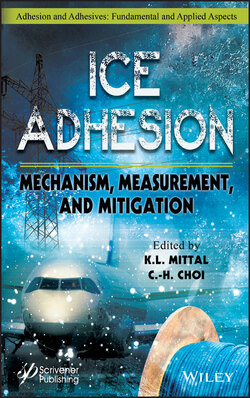Читать книгу Ice Adhesion - Группа авторов - Страница 50
3.2.2 Scenario II: Droplet in an Environment with External Airflow
ОглавлениеSecond scenario occurs when there is airflow around the water droplet in which convective heat transfer becomes significant (Figure 3.8). In this case, instead of solid-liquid interface, ice nucleation occurs at liquid-vapor interface, as convective heat transfer reduces temperature at the surface [24]. Figure 3.8 shows ice growth pattern for the droplet exposed to an environment with airflow.
Figure 3.8 Ice growth on a sub-zero substrate when the droplet is in an environment with external airflow. In this case, ice growth is controlled mainly by convective heat transfer through airflow [5].
Similarly to Scenario I, one can use energy balance at phase-changing interface to obtain ice growth rate. The enthalpy released from freezing makes a heat flux at ice-water interface which is carried out with airflow. Thus,
(3.28)
Where is convective heat transfer coefficient. In this case, the Nusselt number, written as a function of diameter which is representative dimension (NuD), by which one can obtain convective heat transfer coefficient, is written as Eq. (3.29) [25]. Note that there is no evaporation on the droplet surface, since ice is formed around the droplet.
Where ReD is Reynolds number for external airflow, Pr is Prandtl’s number and μ is dynamic viscosity. Note that Prandtl’s number for air at -20°C is 0.75. Considering ice growth, a quasi-steady process, by energy balance at water-ice interface Eq. (3.23) can be obtained in this case as well. Due to the radial ice growth, the velocity of freezing front is written as Eq. (3.30).
According to energy balance Eq. (3.31) could be obtained as,
Where Ai is ice-water interface area and Ao is ice-air interface area. By substituting Eq. (3.23) and (3.30) in Eq. (3.31), the following equation is obtained,
(3.32)
Now, we can find an equation for ice growth rate. Through solution of heat equation in spherical coordinates, we have,
(3.33)
T(r = ri) = Tf and T(r = r0) = Ts are ice-water and ice-air interface temperatures, respectively. The boundary conditions are written as,
By applying boundary conditions on Eq. (3.34), we have,
We define,
Thus,
(3.35)
(3.36)
The surface temperature is as follows:
where and θs = Ts–T∞. By substitution of C1 and C2, the following equation for θs is obtained:
Thus, is written as:
And may be simplified to
Where Biot number is defined as:
By writing the energy balance at the ice-water interface one has:
(3.38)
By substitution of θs from Eq. (3.37) in Eq. (3.39):
And by simplification of this equation, one finds
Through integration of both sides:
And we have the initial condition for ice growth as:
Thus,
Through Eq. (3.40), the radius of ice as a function of time, i.e. ice growth rate, in high air flow condition is obtained. Irajizad et al. [5] plotted Eq. (3.40) for different air velocities and temperatures. As shown in Figure 3.9, the initial rate of ice growth is low. However, the rate of ice growth increases as the ice growth proceeds.
A critical factor in ice growth in airflow is humidity. For example, in the presence of airflow, at humidity of 30-75%, ice nucleation occurs at liquid-vapor interface which is called homogeneous nucleation, while at humidity close to 100%, heterogeneous ice nucleation which is ice nucleation at solid-liquid interface occurs [24]. This phenomenon can be justified by evaporation rate. Evaporation rate is higher at lower humidity. Therefore, at lower humidity high rate of evaporation cools down the liquid-vapor interface leading to ice nucleation at this interface. On the other hand, once evaporation rate is low in high humidity, ice nucleation occurs at solid-liquid interface. Note that humidity also affects ice growth in the environments with airflow. Airflow with higher amount of humidity has higher amount of heat transfer through convection mechanism. In other words, humidity affects convective heat transfer coefficient,
Figure 3.9 The plot of Eq. (3.40) which shows ice growth rate in an environment with external airflow for different environment temperatures and airflow speeds [5].
